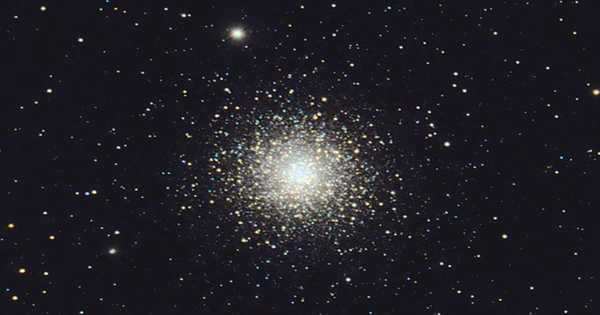HD 209458 b, also known as Osiris, is an exoplanet that orbits the solar analog HD 209458 in the constellation Pegasus, approximately 159 light-years from Earth. It is the first extrasolar planet discovered by its transit across the face of its star, as well as the first extrasolar planet whose mass has been directly measured. Observations of carbon monoxide spectral lines in the atmosphere of HD 209458b revealed that winds with speeds of thousands of kilometers per hour travel from the planet’s dayside to its nightside.
The planet’s orbit has a radius of 7 million kilometers, or about 0.047 astronomical units, or one-eighth the radius of Mercury’s orbit. This small radius results in a year that lasts 3.5 Earth days and a surface temperature of approximately 1,000 °C (approximately 1,800 °F). It has a mass 220 times that of Earth (0.69 Jupiter masses) and a volume 2.5 times that of Jupiter. HD 209458 b’s large mass and volume indicate that it is a gas giant.
Astronomers using the Hubble Space Telescope have detected the atmosphere of a planet orbiting a star outside our solar system for the first time. Their unique observations show that using Hubble and other telescopes, it is possible to measure the chemical makeup of alien planet atmospheres and potentially search for chemical markers of life beyond Earth. The planet revolves around HD 209458, a yellow Sun-like star 150 light-years away in the constellation Pegasus.
HD 209458 b represents a number of milestones in extraplanetary research. It was the first of many categories:
- a transiting extrasolar planet
- the first planet detected through more than one method
- an extrasolar planet known to have an atmosphere
- an extrasolar planet found to have an atmosphere containing oxygen and carbon
- the first extrasolar gas giant to have its superstorm measured
- the first planet to have its orbital speed measured, determining its mass directly.
Based on the application of new theoretical models, it is thought to be the first extrasolar planet discovered to have water vapor in its atmosphere as of April 2007. NASA announced in July 2014 the discovery of very dry atmospheres on HD 209458 b and two other exoplanets (HD 189733 b and WASP-12b) orbiting Sun-like stars.

Physical characteristics
Stratosphere and upper clouds
At an altitude of 1.29 Jupiter radii above the planet’s center, the atmosphere has a pressure of one bar. The atmosphere is clear (probably hydrogen) and its Rayleigh effect is detectable at 33±5 millibars. The temperature at that pressure is 2200±260 K.
The planet’s albedo (or reflectivity) was initially limited to less than 0.3 by observations by the orbiting Microvariability and Oscillations of STars telescope, making it a surprisingly dark object. (Since then, the geometric albedo has been measured to be 0.038 ± 0.045.) Jupiter, on the other hand, has a much higher albedo of 0.52. This implies that HD 209458 b’s upper cloud deck is either less reflective than Jupiter’s, or that it lacks clouds and Rayleigh-scatters incoming radiation like Earth’s dark ocean.
Exosphere
Surrounding that level, the Hubble Space Telescope detected sodium on November 27, 2001, the first planetary atmosphere outside the Solar System to be measured. Sara Seager predicted this detection in late 2001. The sodium line’s core operates at pressures ranging from 50 millibars to a microbar.
Astronomers discovered an enormous ellipsoidal envelope of hydrogen, carbon, and oxygen around the planet that reaches 10,000 K using the Hubble Space Telescope Imaging Spectrograph in 2003–4. The hydrogen exosphere reaches a distance of RH=3.1 RJ, which is much greater than the planetary radius of 1.32 RJ. The Maxwell–Boltzmann distribution of particle velocities produces a significant ‘tail’ of atoms moving faster than the escape velocity at this temperature and distance.
The analysis of starlight passing through the envelope reveals that the planet’s heavier carbon and oxygen atoms are being blown away by the extreme “hydrodynamic drag” created by its evaporating hydrogen atmosphere. The planet’s hydrogen tail is approximately 200,000 kilometers long, which is roughly equivalent to its diameter.
Atmosphere composition
Travis Barman of the Lowell Observatory announced evidence that the atmosphere of HD 209458 b contained water vapor on April 10, 2007. Barman discovered strong evidence for water absorption in the planet’s atmosphere using a combination of previously published Hubble Space Telescope measurements and new theoretical models.
Barman used Hubble Space Telescope data and measurements taken by Heather Knutson, a Harvard University student, and applied new theoretical models to demonstrate the likelihood of water absorption in the planet’s atmosphere.
According to a research summary, atmospheric water absorption in such an exoplanet causes it to appear larger in one part of the infrared spectrum when compared to wavelengths in the visible spectrum. Barman allegedly identified water absorption in the planet’s atmosphere using Knutson’s Hubble data on HD 209458 b and his theoretical model.
Instead, water vapor, carbon monoxide, hydrogen cyanide, methane, ammonia, and acetylene were detected in the refined spectra obtained in 2021, all of which are consistent with the extremely high carbon to oxygen molar ratio of 1.0 (compared to the Sun’s C/O molar ratio of 0.55). If confirmed, HD 209458 b could be a prime example of a carbon planet.
















